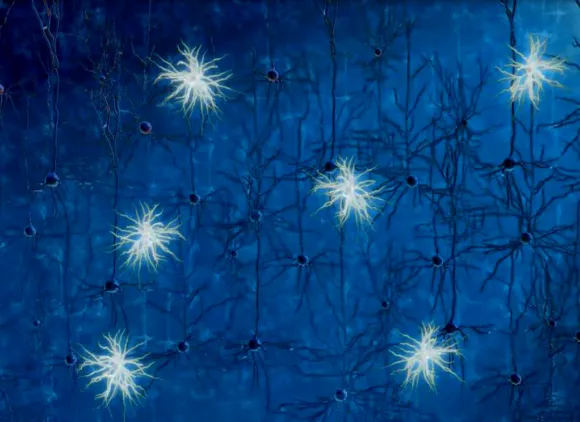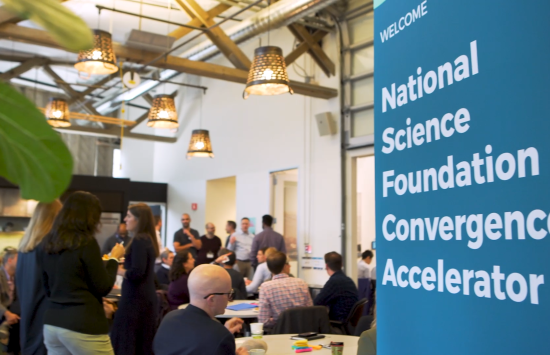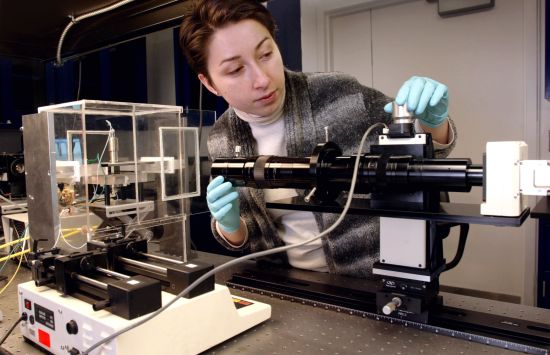
Credit: Domenico Pacifici, School of Engineering, Brown University
Convergence research is a means of solving vexing research problems, especially those focusing on societal needs. It has two primary characteristics:
- It is driven by a specific and compelling problem, whether that problem arises from deep scientific questions or pressing societal needs.
- It shows deep integration across disciplines. Convergence research intentionally brings together intellectually diverse researchers to develop effective ways of communicating across disciplines. As experts from different disciplines pursue a common research challenge, their knowledge, theories, methods, data and research communities increasingly intermingle.
New frameworks, paradigms or even disciplines can emerge from convergence research, as research communities adopt common frameworks and a new scientific language. In this sense, convergence research is similar to transdisciplinary research, which is seen as the pinnacle of integration across disciplines.
Examples of convergence research:
A convergence of the life sciences, physical sciences, computer sciences and engineering is driving research in cyber-physical systems — smart networked systems with embedded sensors, processors and actuators that are designed to sense and interact with the physical world.
In cyber-physical systems, the joint behavior of the "cyber" and "physical" elements of the system is critical: computing, control, sensing and networking can be deeply integrated into every component, and the actions of components and systems must be safe and interoperable.
NSF's Cyber-Physical Systems program awards "Frontier" grants to projects that are developing solutions to challenges that cannot be achieved by small efforts. Examples of these projects include:
- A Cyber-Physical System for Monitoring, Analysis and Mitigation of Urban Noise Pollution. This project uses machine learning, Big Data analysis and public participation in scientific research to monitor and mitigate urban noise pollution more effectively.
- Verified Human Interfaces, Control and Learning for Semi-Autonomous Systems. This project is developing human cyber-physical systems — systems that operate in concert with human operators — to improve the interaction between humans, computers and the physical world.
A convergence of the life sciences, engineering, statistics and computer science is driving new research into how the mind works.
NSF's Science and Technology Research Centers program, one of the agency's principal means for fostering convergence research, supports centers focusing on the mind and brain, including:
- The Center for Behavioral Neuroscience: The center has played a major role in developing the field of behavioral neuroscience. Its scientists study the neuroscience of affiliation, aggression, fear, reproduction, and memory and cognition.
- The Center for Brains, Minds and Machines: The center brings together computer scientists, cognitive scientists and neuroscientists to understand human intelligence and establish an engineering practice based on that understanding.
Synthetic biology aims to construct or redesign biological entities to solve problems. It builds on another convergent field — nanotechnology — which came into being through the convergence of chemistry, physics, engineering, life sciences, materials science and many other disciplines.
NSF's Science and Technology Research Centers focusing on synthetic biology include:
- The Synthetic Biology Research Center: The center has trained engineers to specialize in engineering biology. These engineers will use synthetic biology to build technologies that solve engineering challenges in health care, energy and the environment.
- The Center for Biorenewable Chemicals: The center is bringing together biologists and chemists to build a sustainable bio-based chemical industry.
1. Need for a convergent approach
The research team makes a compelling case for why it is essential to bring together substantially different science and engineering disciplines to address a specific scientific challenge or social problem.
2. Readiness to engage in convergence research
The research team provides evidence of its readiness to perform the proposed research and that the necessary disciplines are represented on the team. This evidence may include previous interdisciplinary projects or joint publications by team members, specialized knowledge residing in the research team that is pertinent to the problem, or co-development of research infrastructure.
3. Integration of knowledge, tools and modes of thinking
The research team makes a compelling case that the knowledge of its contributing disciplines is deeply integrated. It demonstrates strong coupling, high leveraging, or co-development of integrated or complementary tools and techniques. It also demonstrates a novel research approach that deeply integrates its contributing disciplines' knowledge and modes of thinking.
4. Involvement of the next generation of convergence researchers
The research team gives undergraduate students, graduate students and/or postdoctoral fellows opportunities to learn convergence research approaches — and is clear about the tools, techniques and concepts outside their disciplinary specialties they'll learn. Ideally, a project should offer a model learning environment that can be adapted by other convergence research projects.
How NSF supports convergence research
The convergence of disciplines is a process — NSF's convergence research portfolio focuses on addressing the key technical, organizational and logistical challenges that currently hinder convergence research.
NSF's programs support teams with varying degrees of integration between their disciplines, and at varying stages of readiness to adopt a convergence strategy, through grants, workshops and cooperative agreements.
Featured NSF-wide programs:
Offers intense hands-on education and mentoring to teams that focus on translating basic research into solutions with real-world application.
Supports team-based research that crosses disciplinary boundaries and addresses challenges falling outside of NSF's existing programs.
Supports interdisciplinary centers that work on complex research challenges in areas of national priority.
Principles and Methods that Facilitate Convergence (Roco 2016)
Describes approaches to facilitate a more effective and rapid process of convergence across scientific and technological domains.
Convergence: The Future of Health (Sharp et al. 2016)
Describes opportunities for convergent approaches in the biomedical sciences, such as in treating brain disorders, cancer, and infection and immunity.
Convergence: Facilitating Transdisciplinary Integration of Life Sciences, Physical Sciences, Engineering, and Beyond (National Research Council 2014)
Characterizes and provides examples of convergence in relation to other forms of research such as multidisciplinary, interdisciplinary and transdisciplinary. Discusses strategies that foster convergence in organizations and revising STEM education to facilitate convergence.
Convergence of Knowledge, Technology and Society: Beyond Convergence of Nano-Bio- Info-Cognitive Technologies (Roco et al. 2013)
Characterizes convergence as part of a fundamental dynamic, the convergence-divergence cycle, that has existed throughout the history of scientific and technological development.
The Third Revolution: The Convergence of the Life Sciences, Physical Sciences, and Engineering (MIT 2011)
Describes convergence as the third revolution in biomedical research, following molecular/cellular biology and genomics.
The Co-evolution of Human Potential and Converging Technologies (Roco and Montemagno 2004)
Concludes that "human abilities in learning, working and active aging will intimately depend on the confluence of various technological, medical, cognitive and social developments."
Converging Technologies for Improving Human Performance: Nanotechnology, Biotechnology, Information Technology, and Cognitive Science (Roco et al. 2002)
Describes convergent approaches in a broad set of themes, including expanding human cognition and communication, improving human health and physical capabilities, enhancing group and societal outcomes, national security, and unifying science and education.
Bainbridge, William Sims, and Mihail C. Roco. Handbook of Science and Technology Convergence. Springer, 2015.
National Research Council. Catalyzing Inquiry at the Interface of Computing and Biology. Washington, DC: The National Academies Press, 2005. https://doi.org/10.17226/11480.
National Research Council. Mathematics and 21st Century Biology. Washington, DC: The National Academies Press, 2005. https://doi.org/10.17226/11315.
National Research Council. Inspired by Biology: From Molecules to Materials to Machines. Washington, DC: The National Academies Press, 2008. https://doi.org/10.17226/12159.
National Research Council. Research at the Intersection of the Physical and Life Sciences. Washington, DC: The National Academies Press, 2010. https://doi.org/10.17226/12809.
National Research Council. Toward Precision Medicine: Building a Knowledge Network for Biomedical Research and a New Taxonomy of Disease. Washington, DC: The National Academies Press, 2011. https://doi.org/10.17226/13284.
Roco, Mihail C. "Coherence and Divergence of Megatrends in Science and Engineering." Journal of Nanoparticle Research 4, no. 1 (2002): 9-19.
Roco, Mihail C., and William S. Bainbridge. "The New World of Discovery, Invention, and Innovation: Convergence of Knowledge, Technology, and Society." Journal of Nanoparticle Research 15, no. 9 (2013): 1-17.




